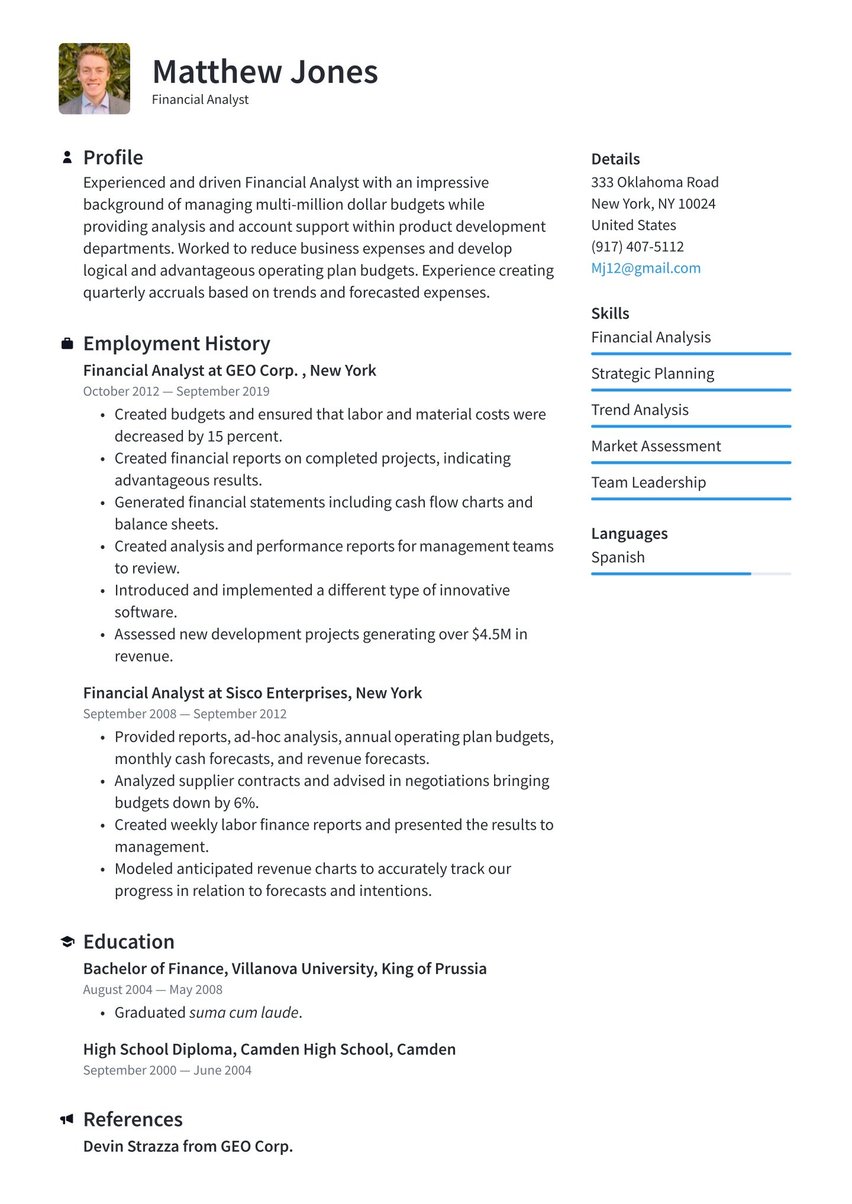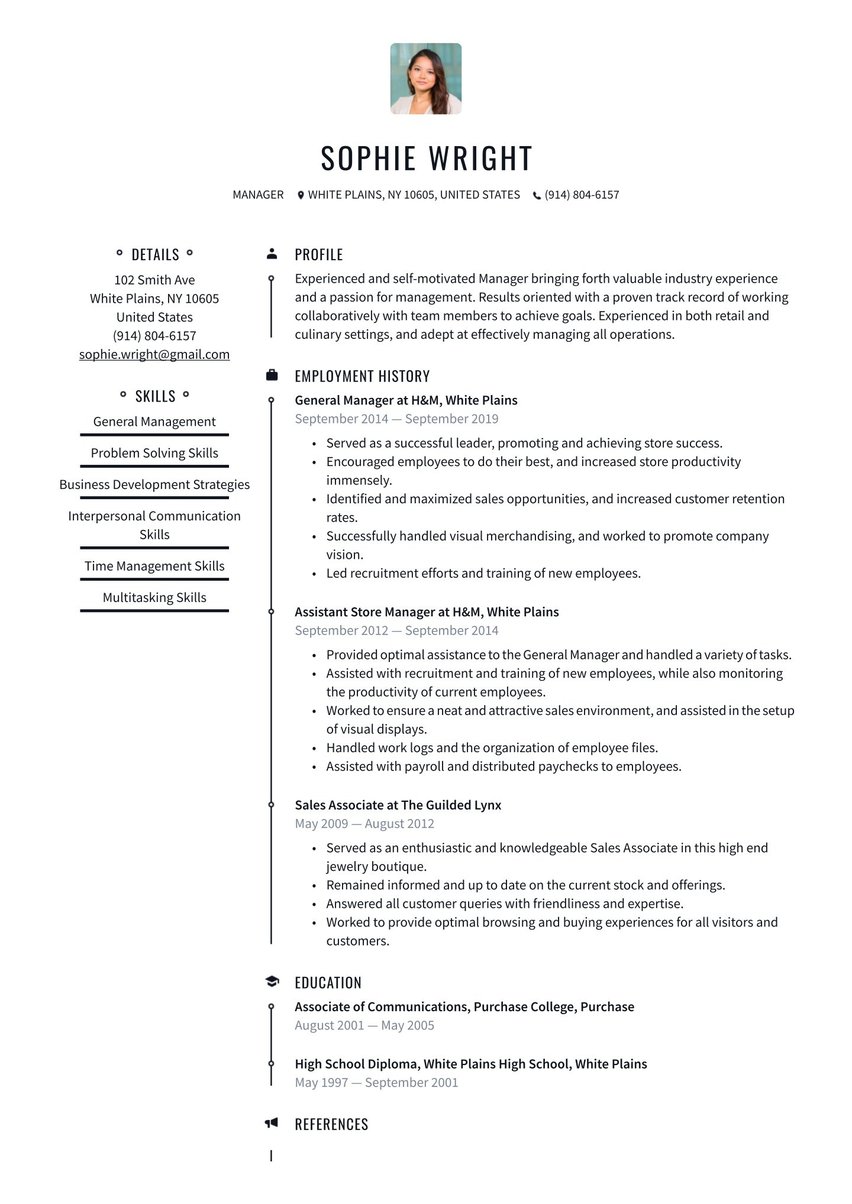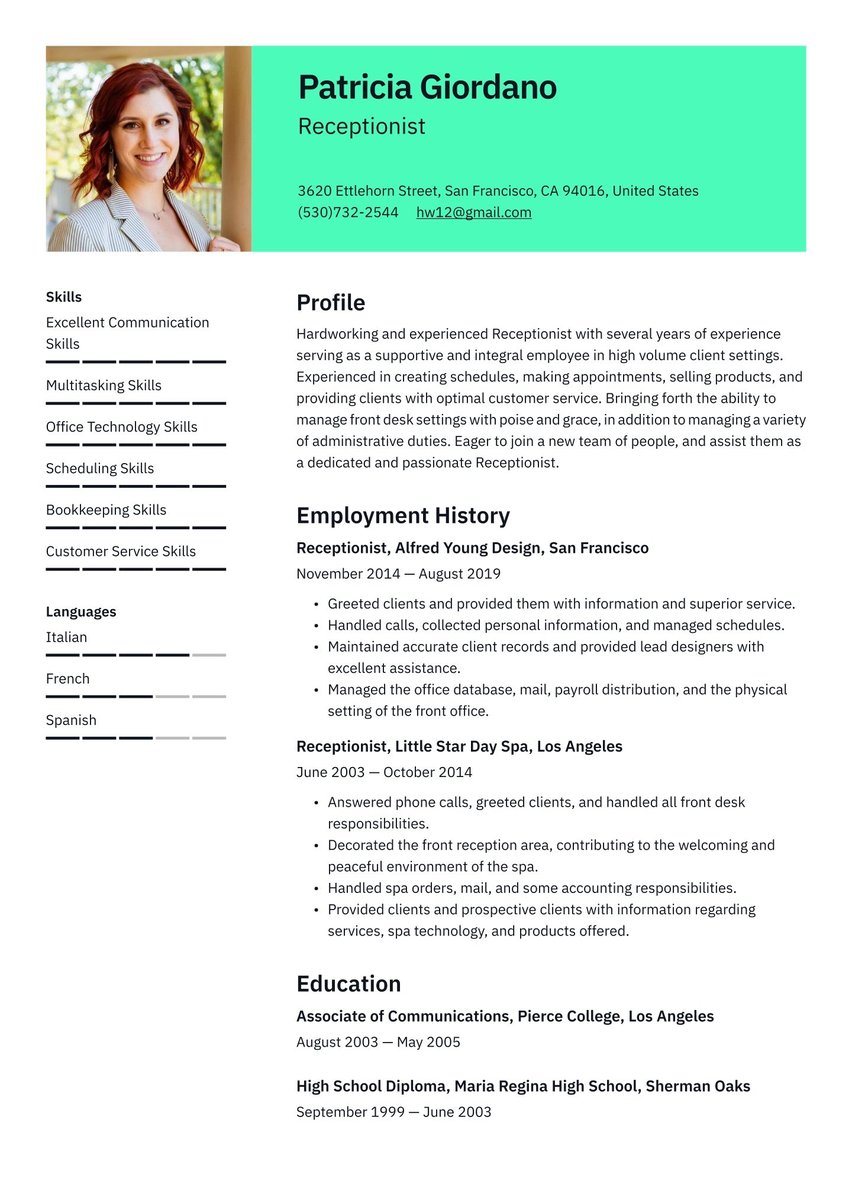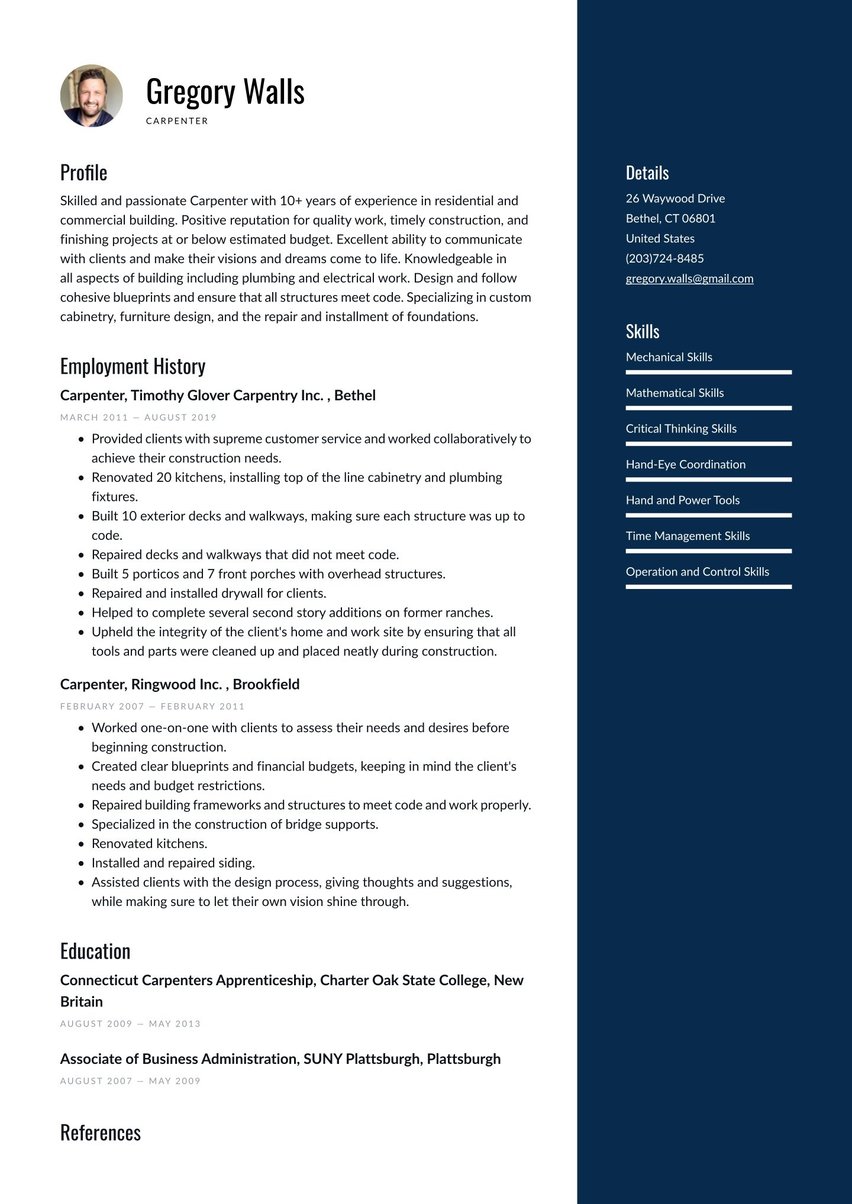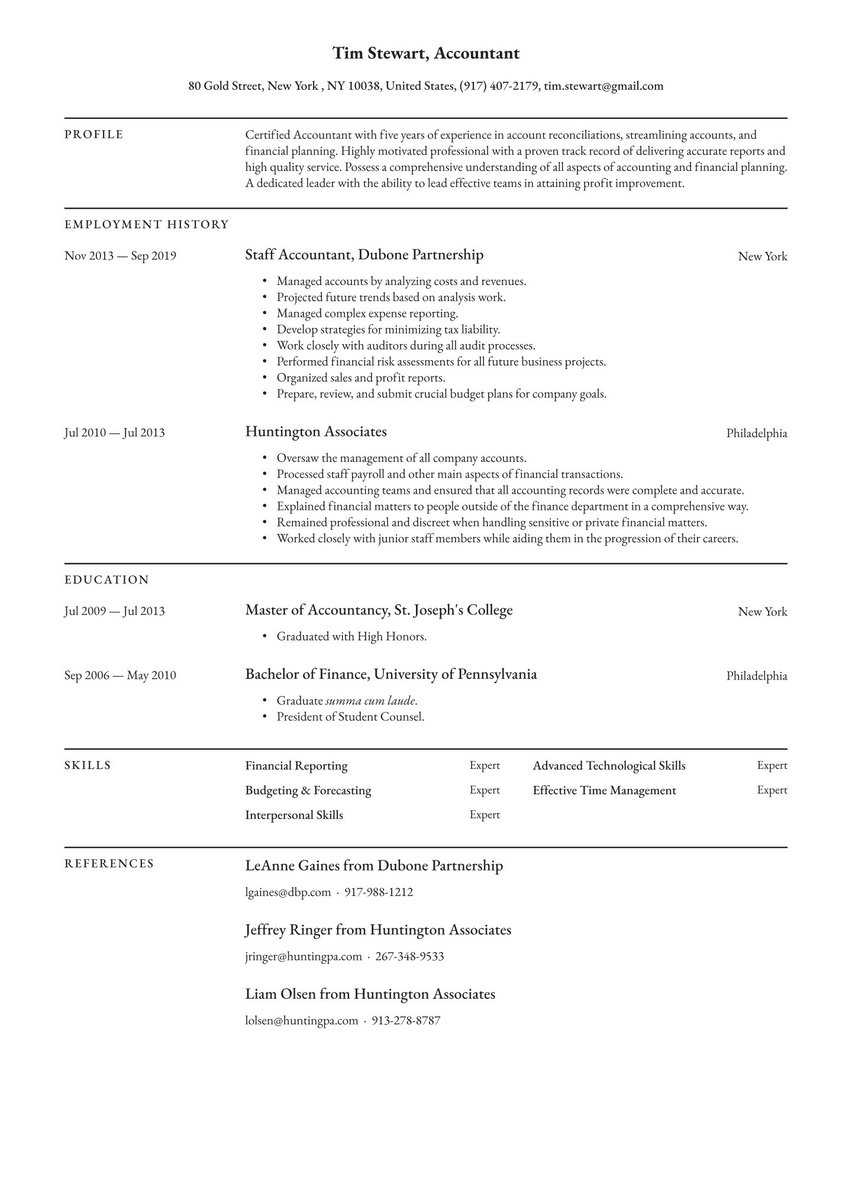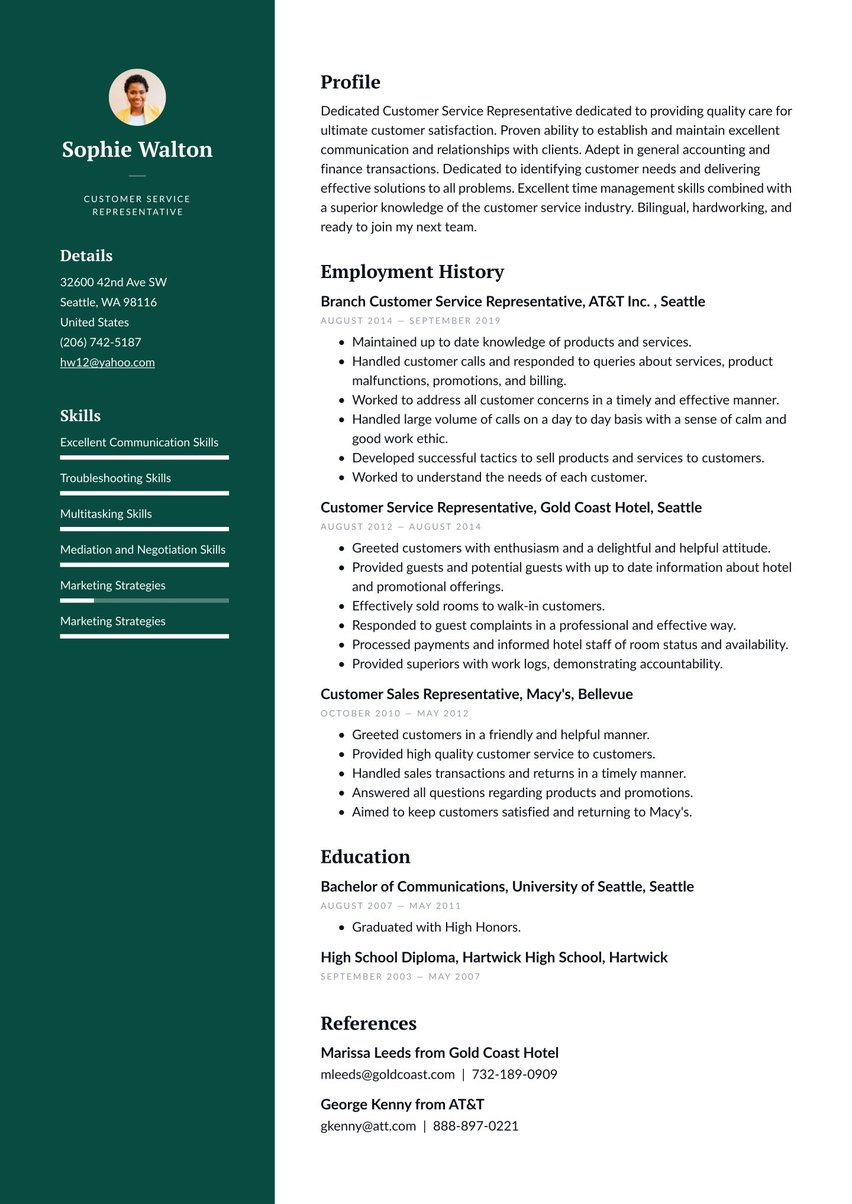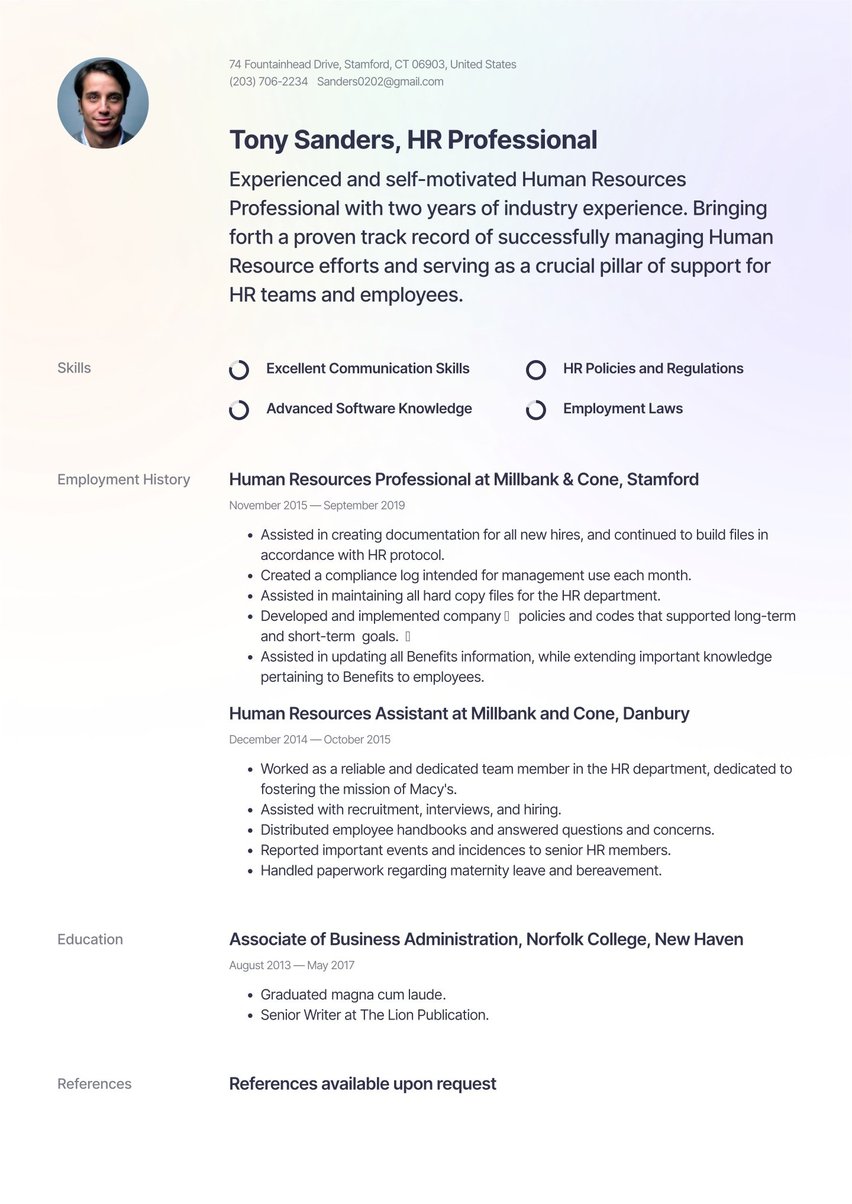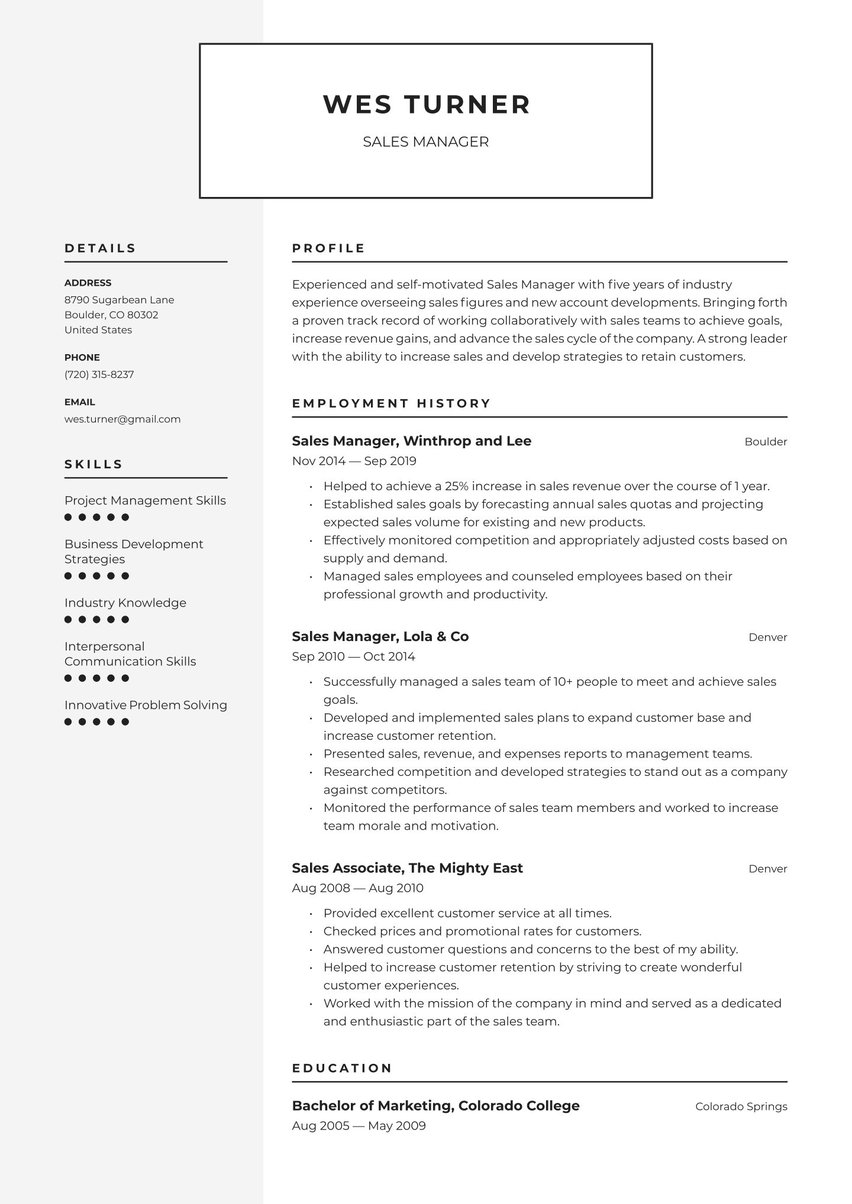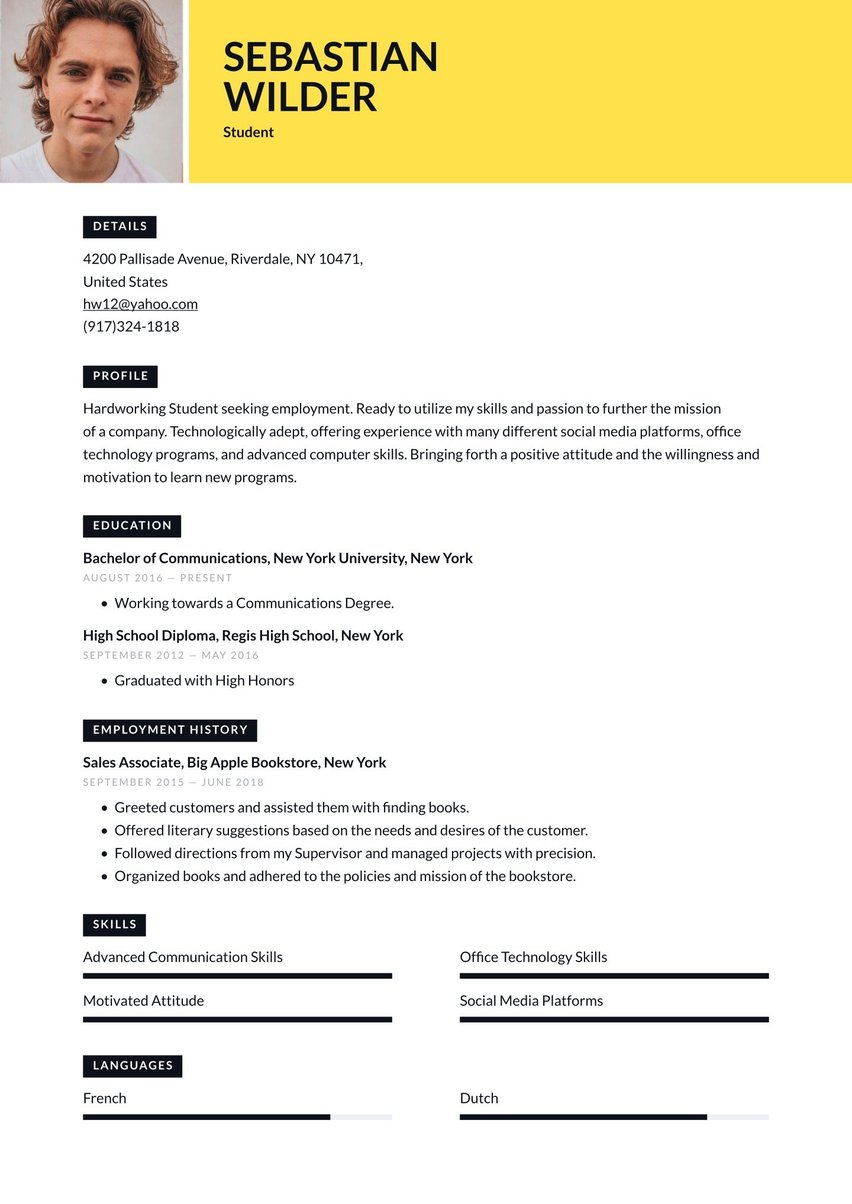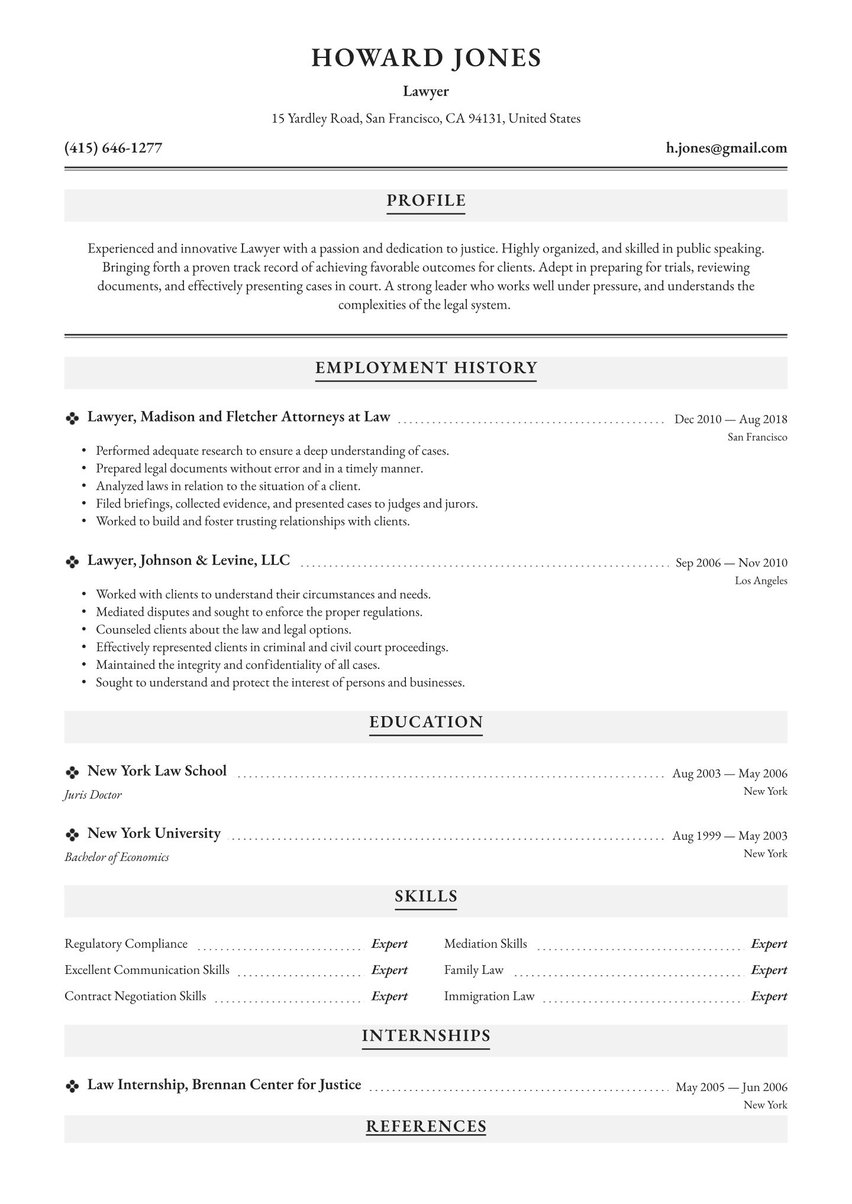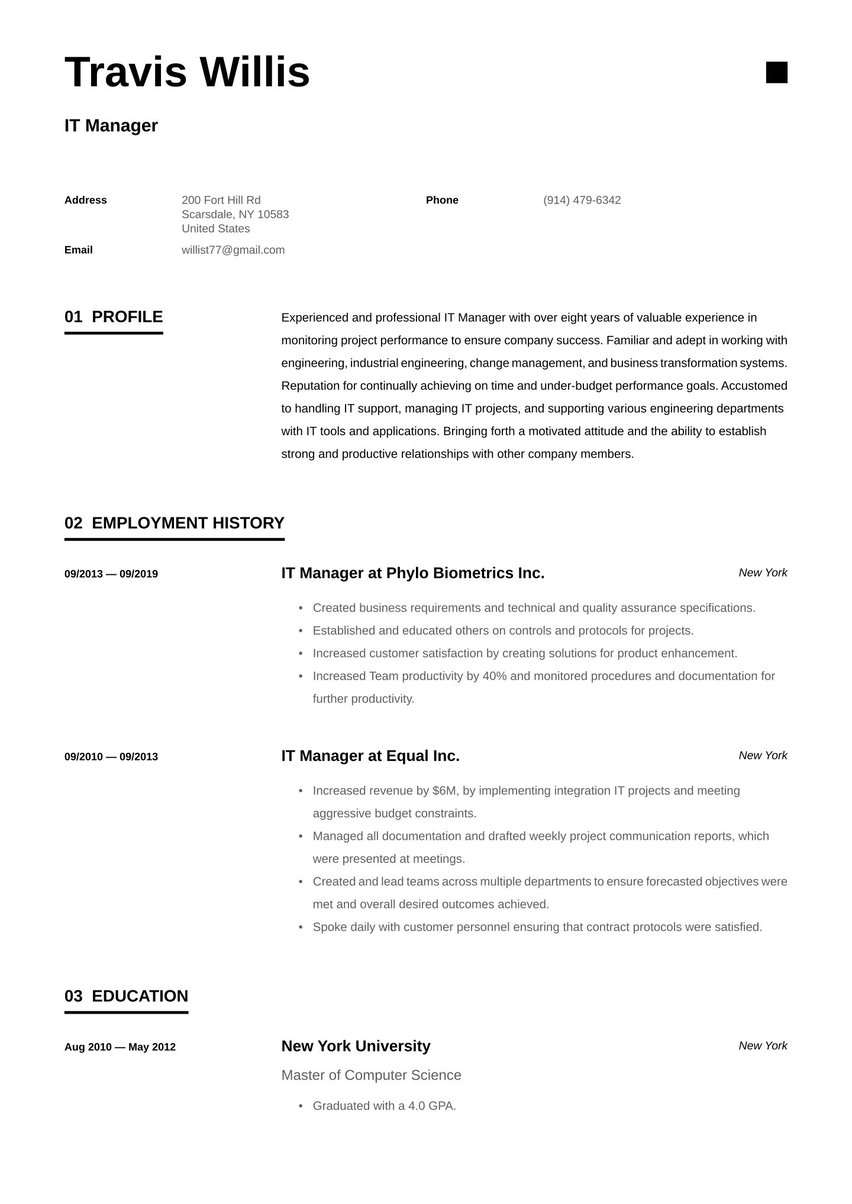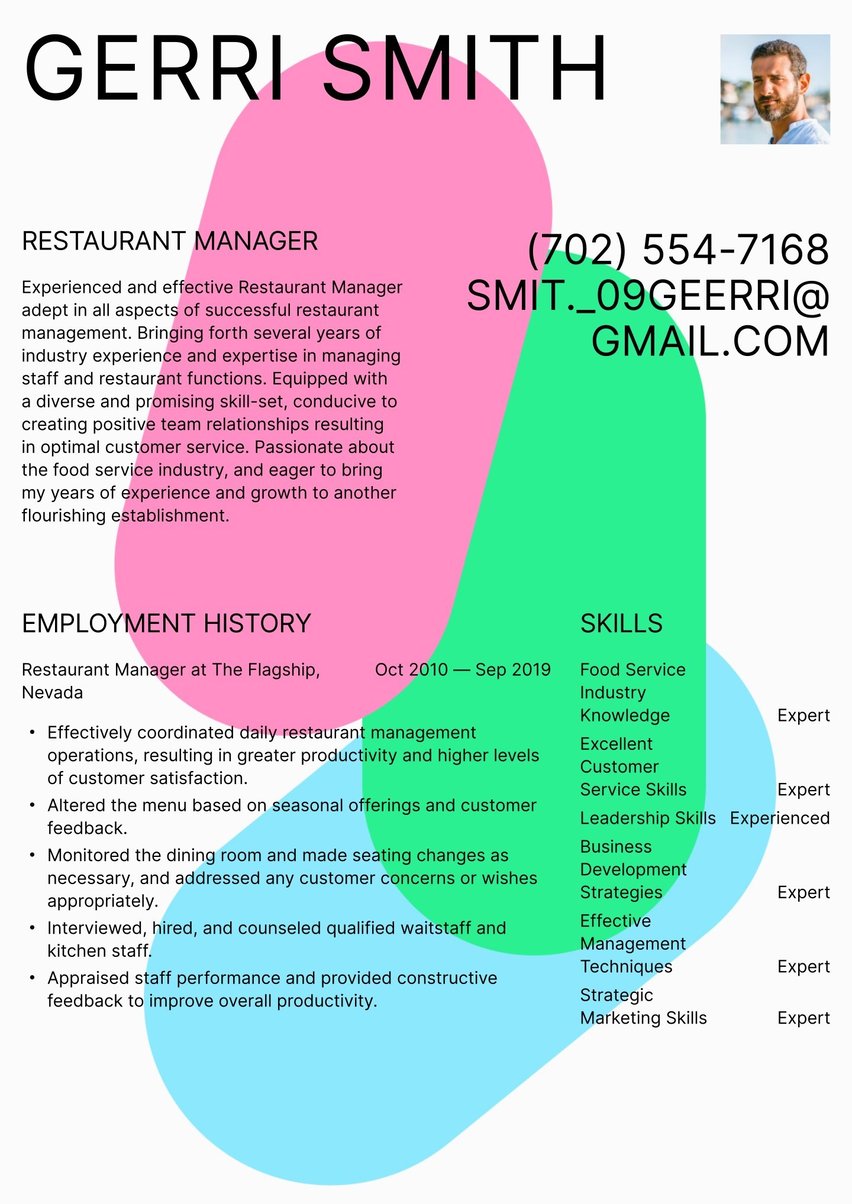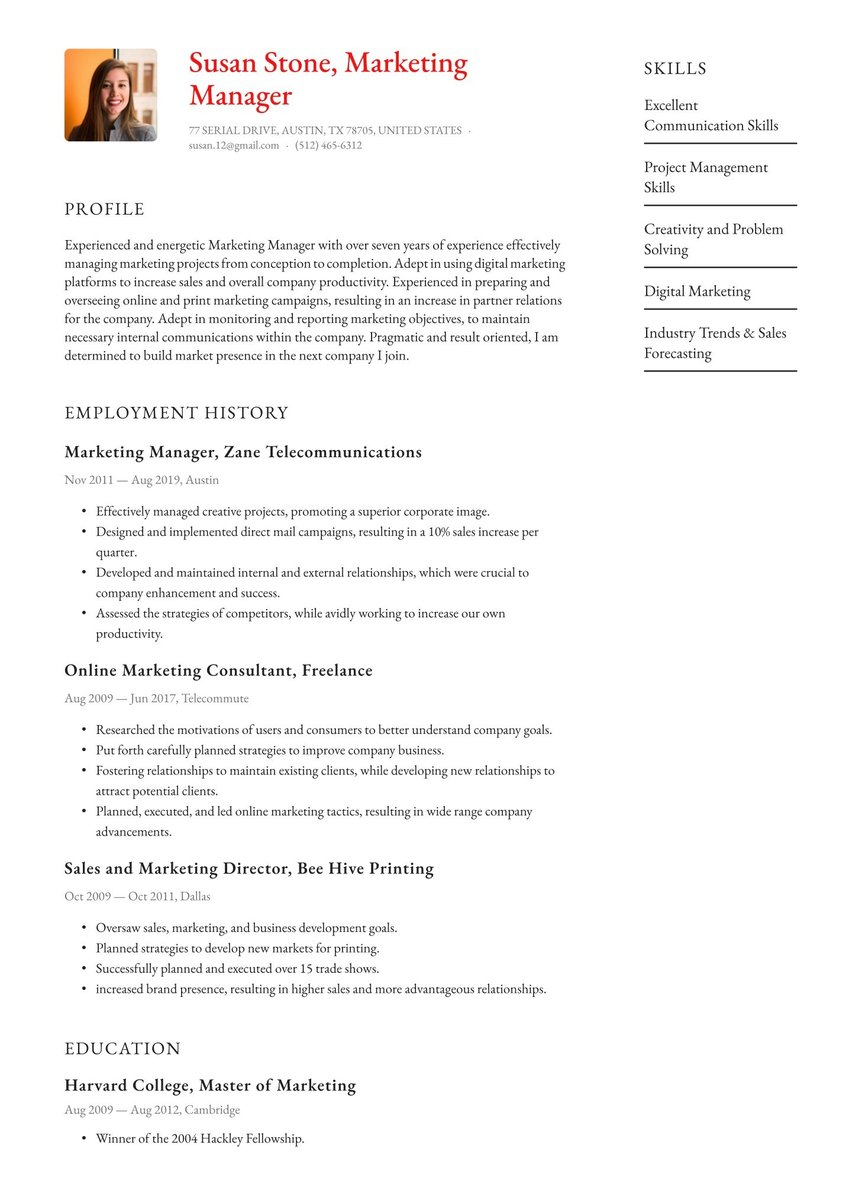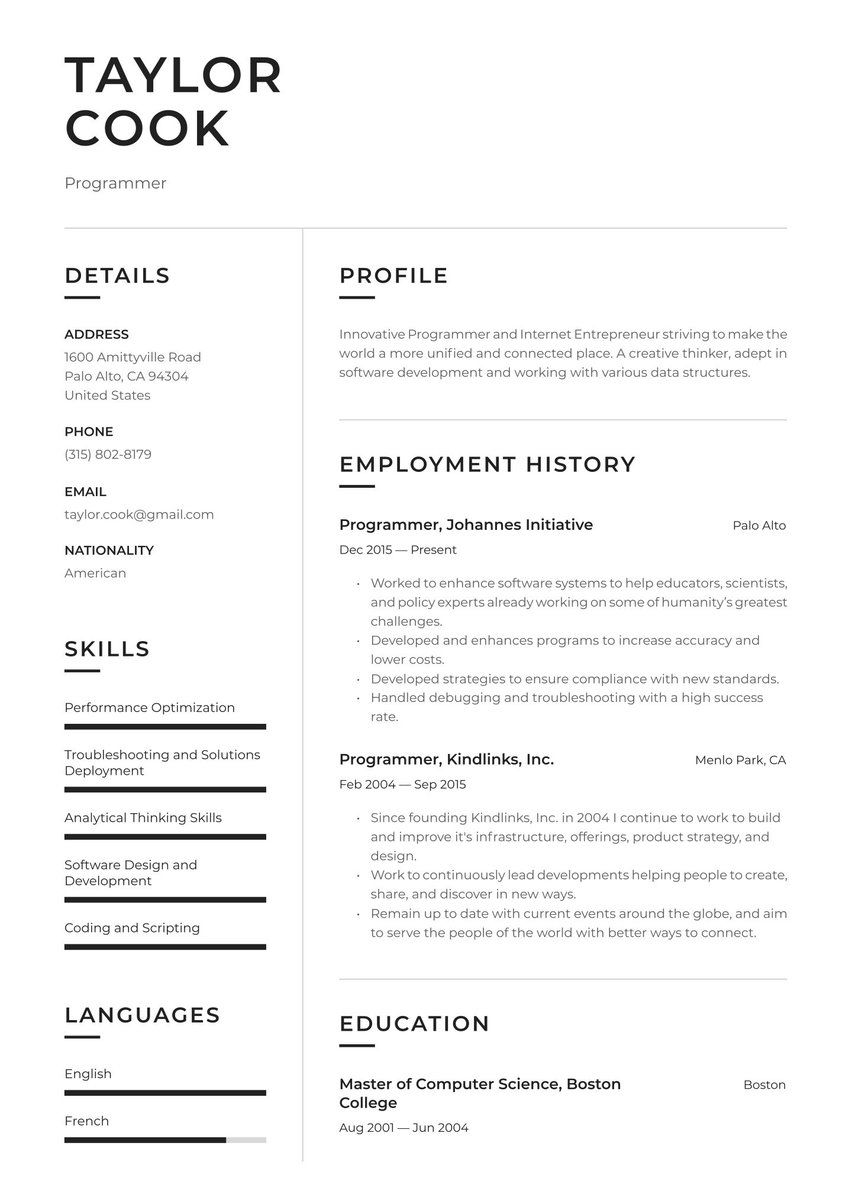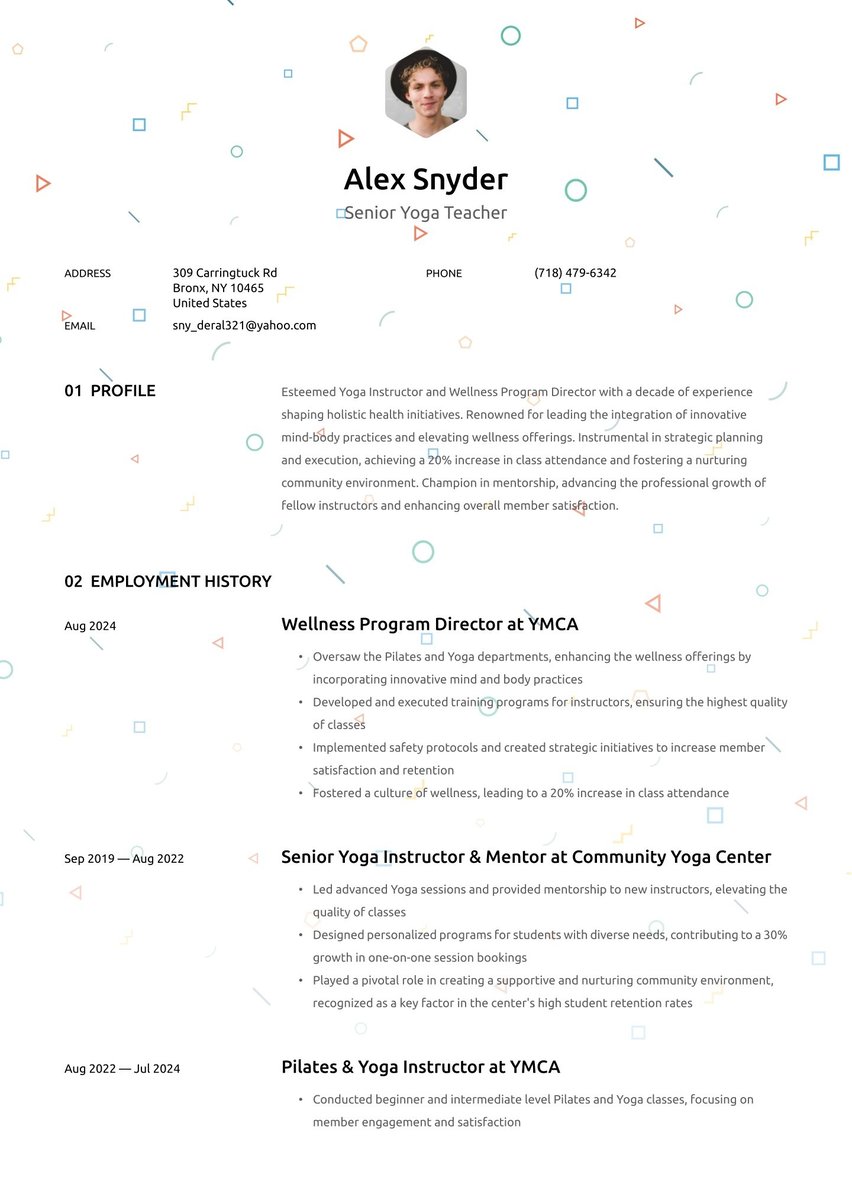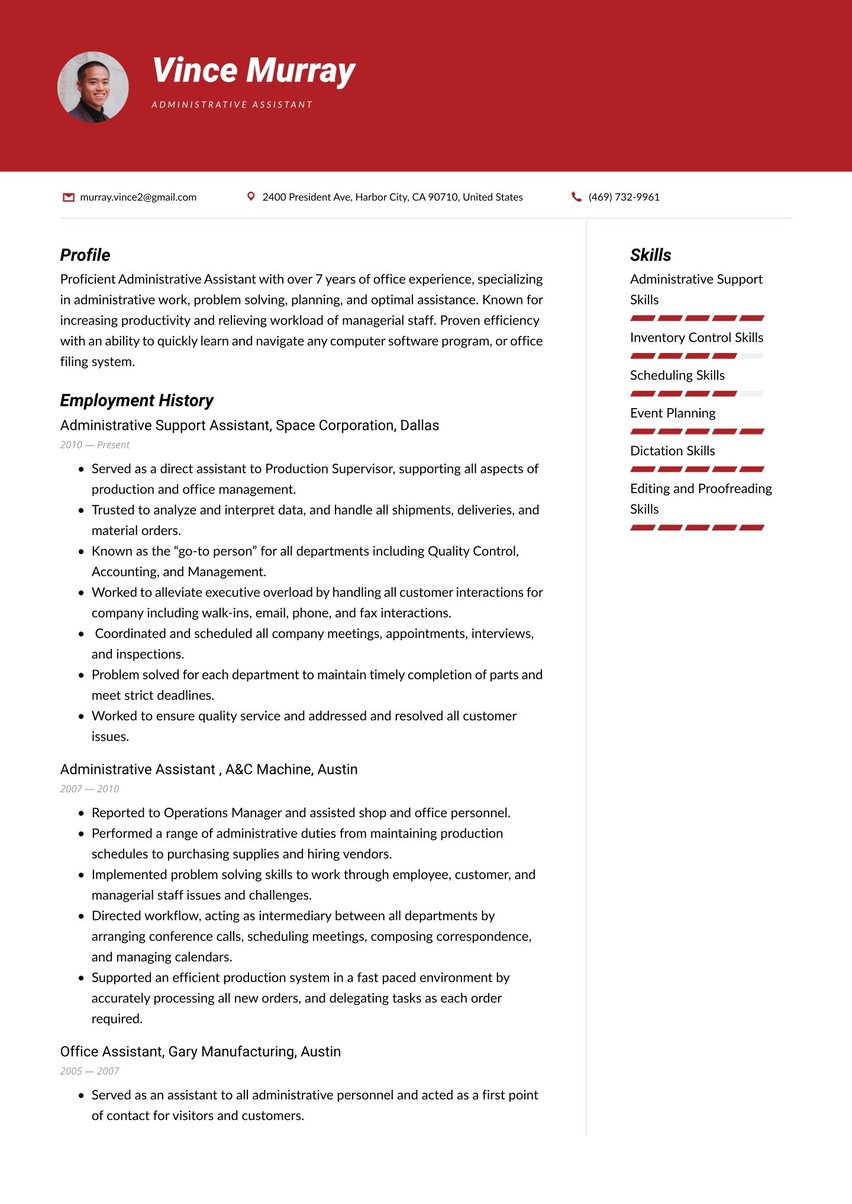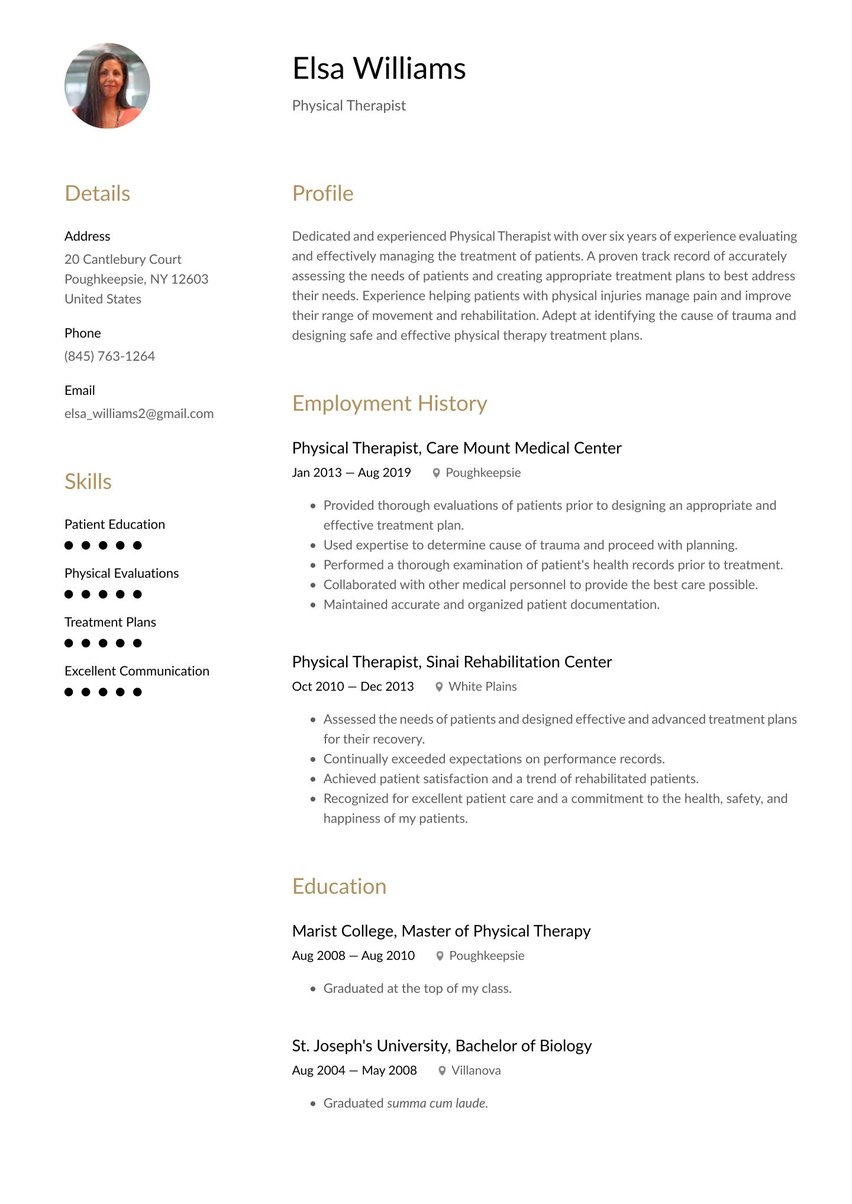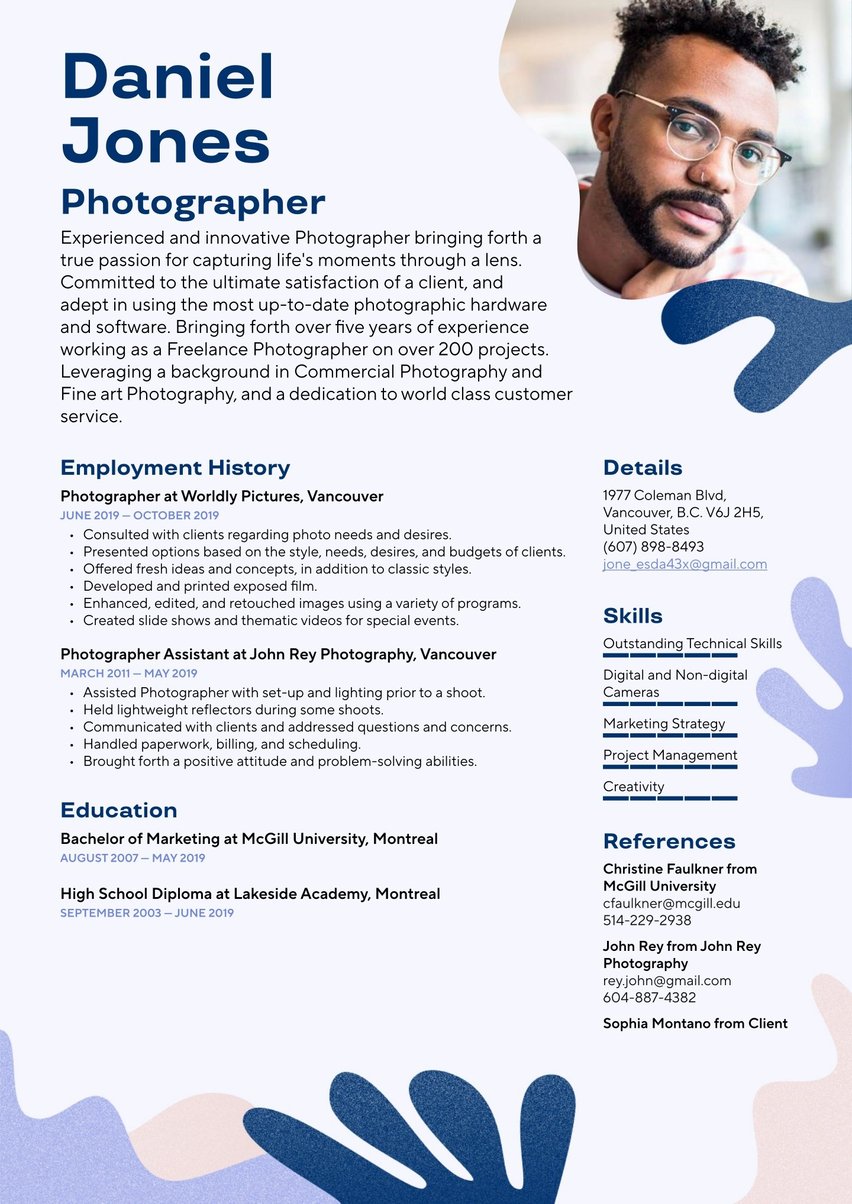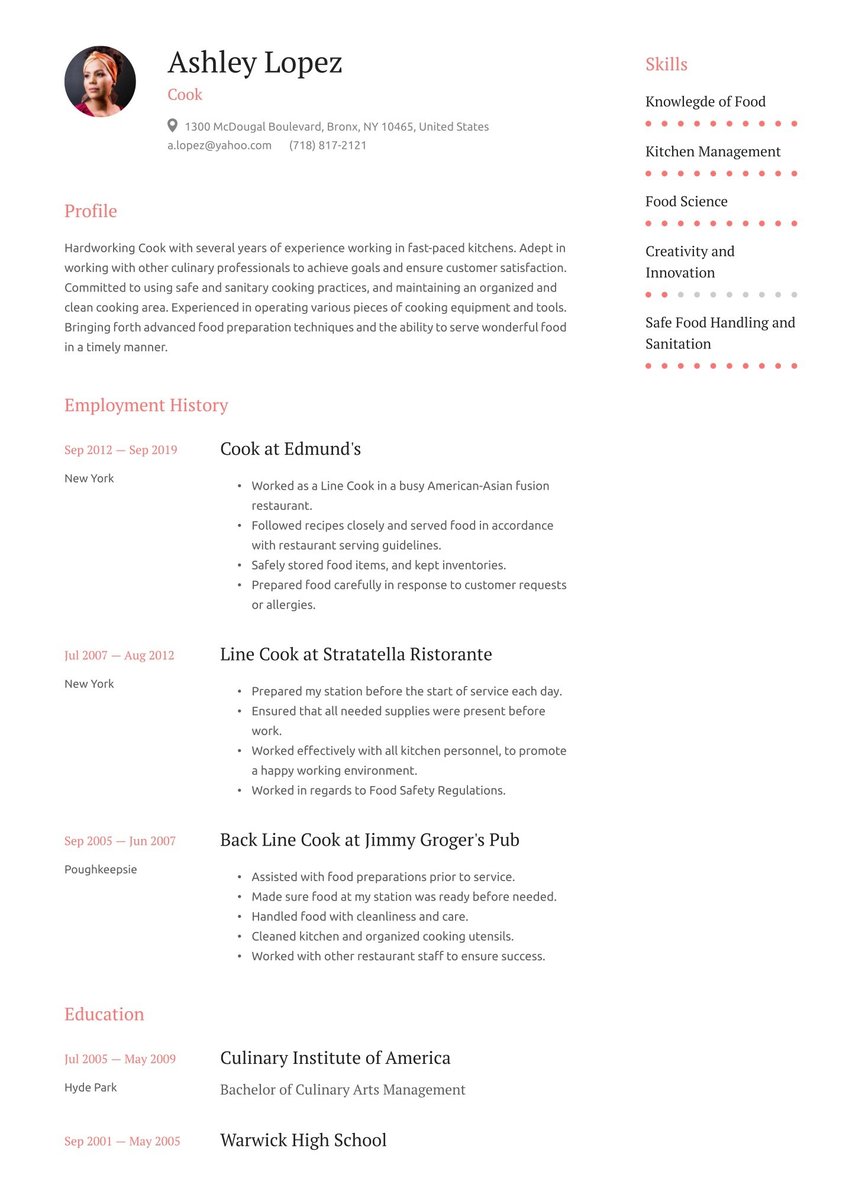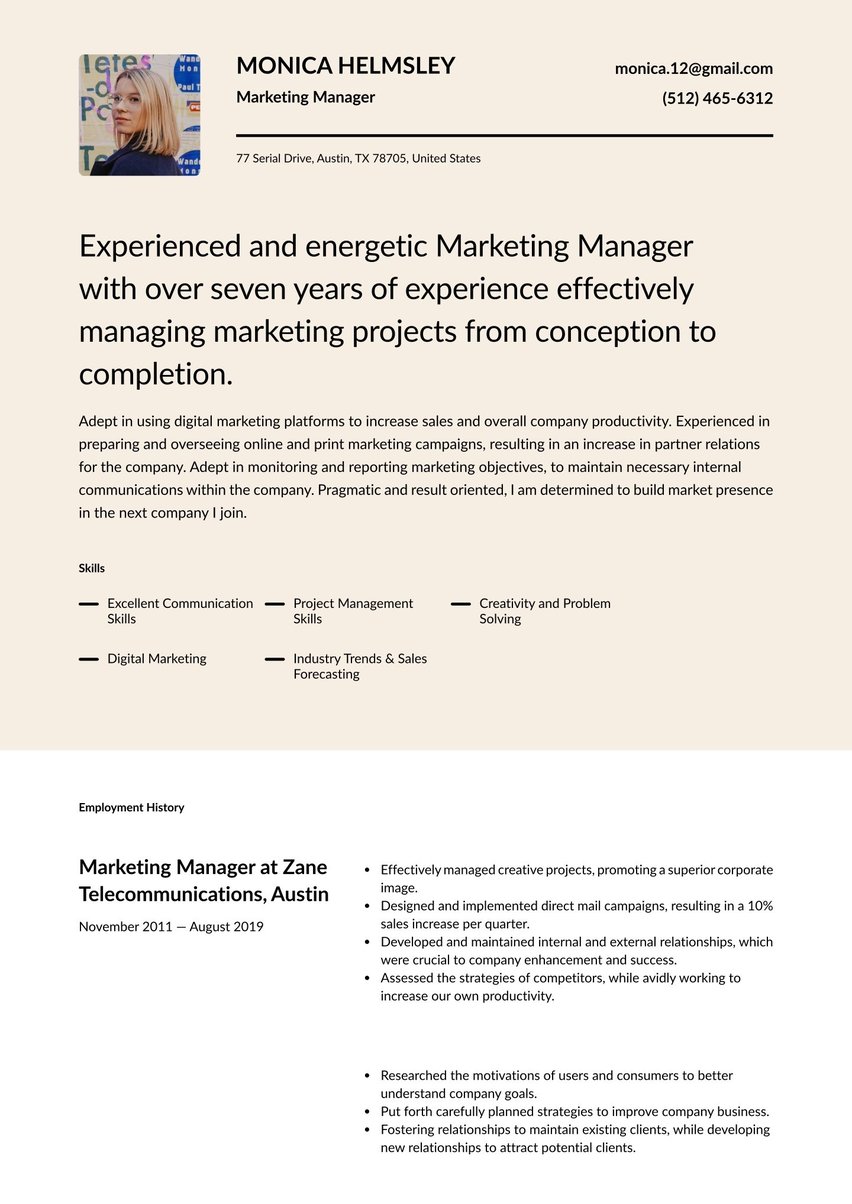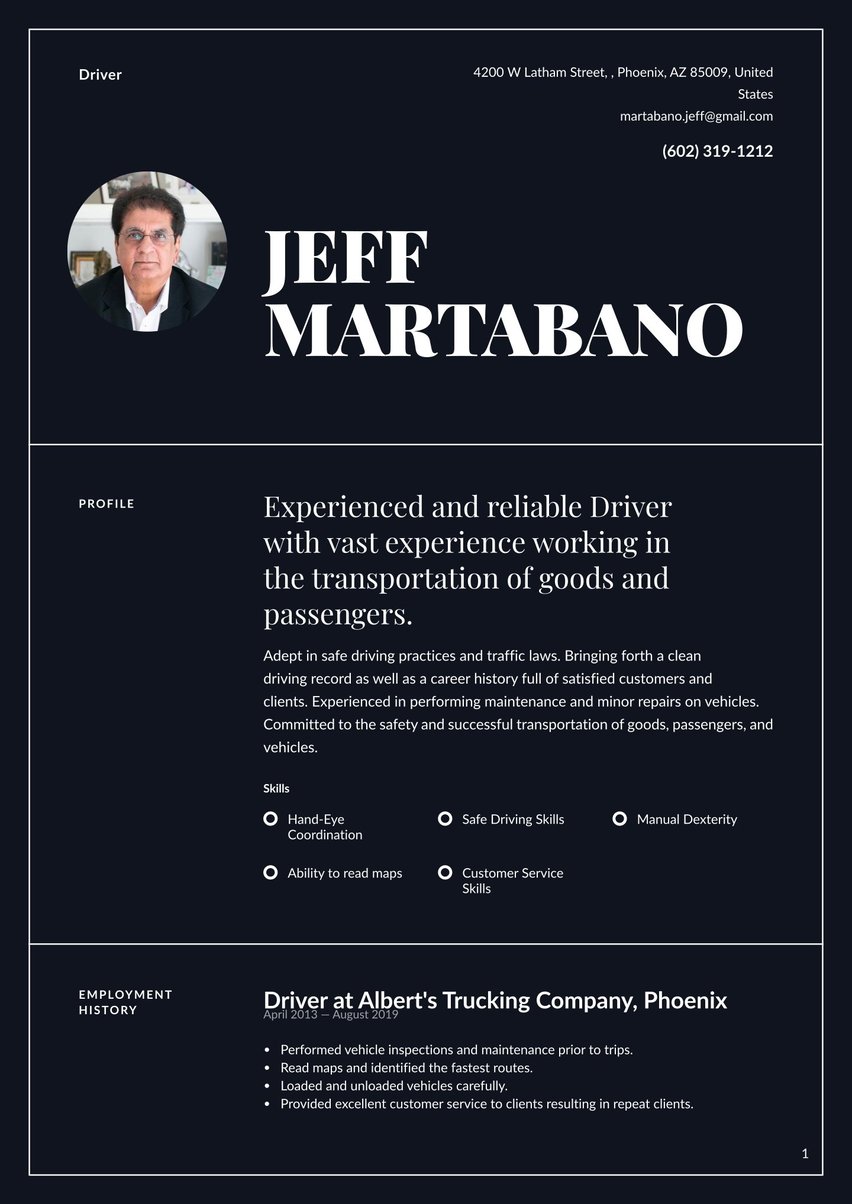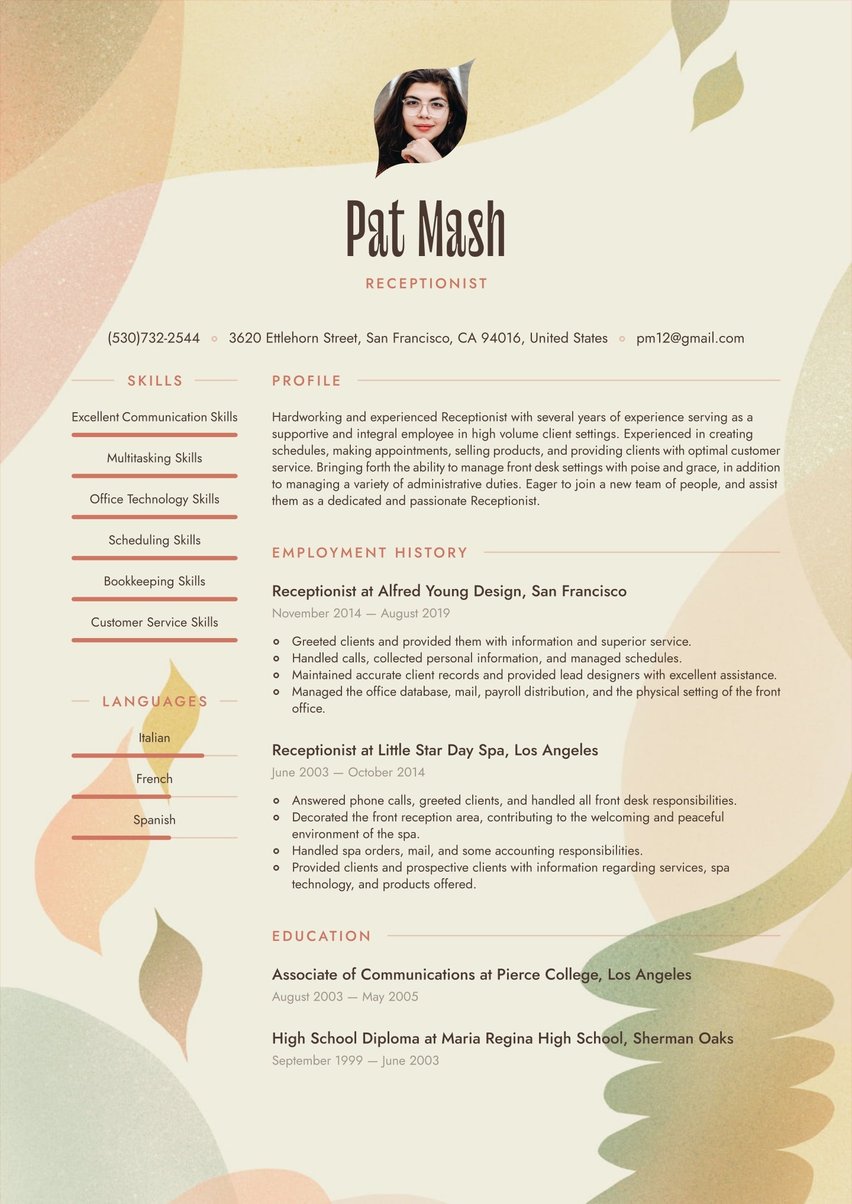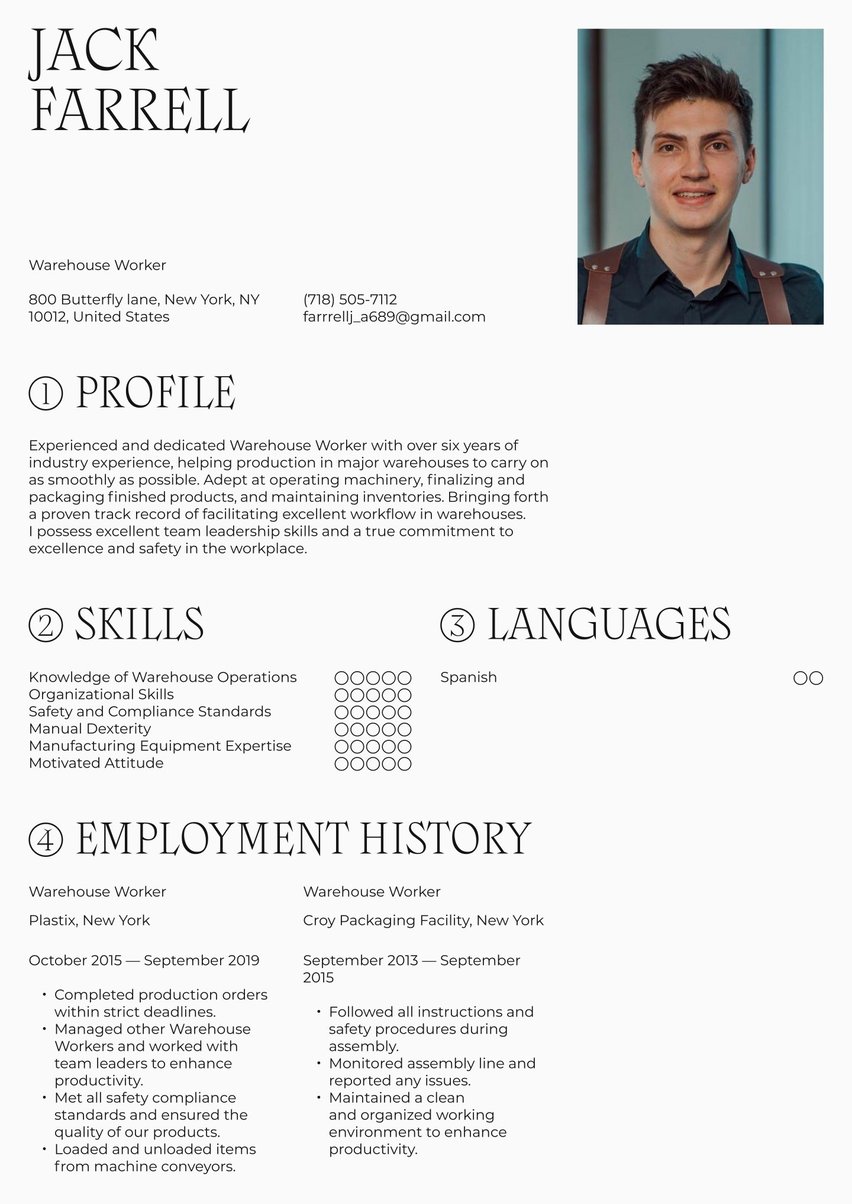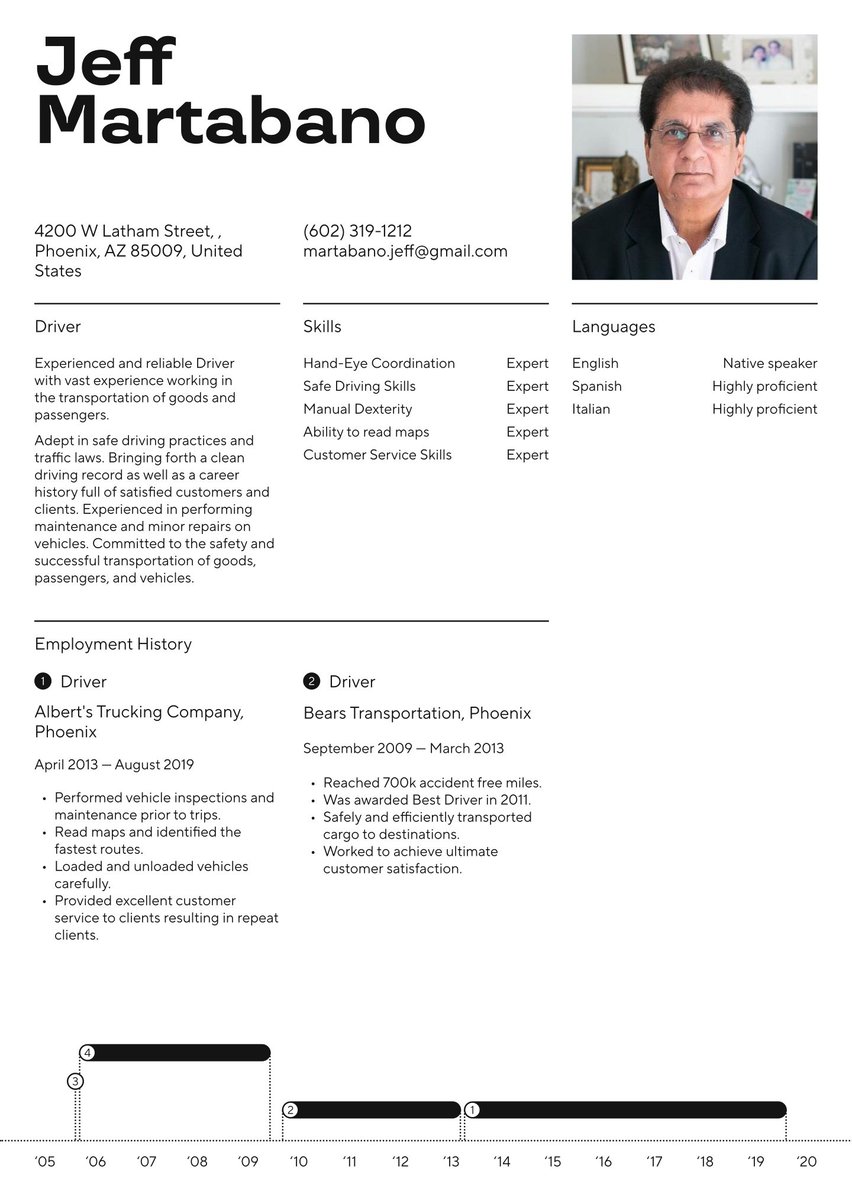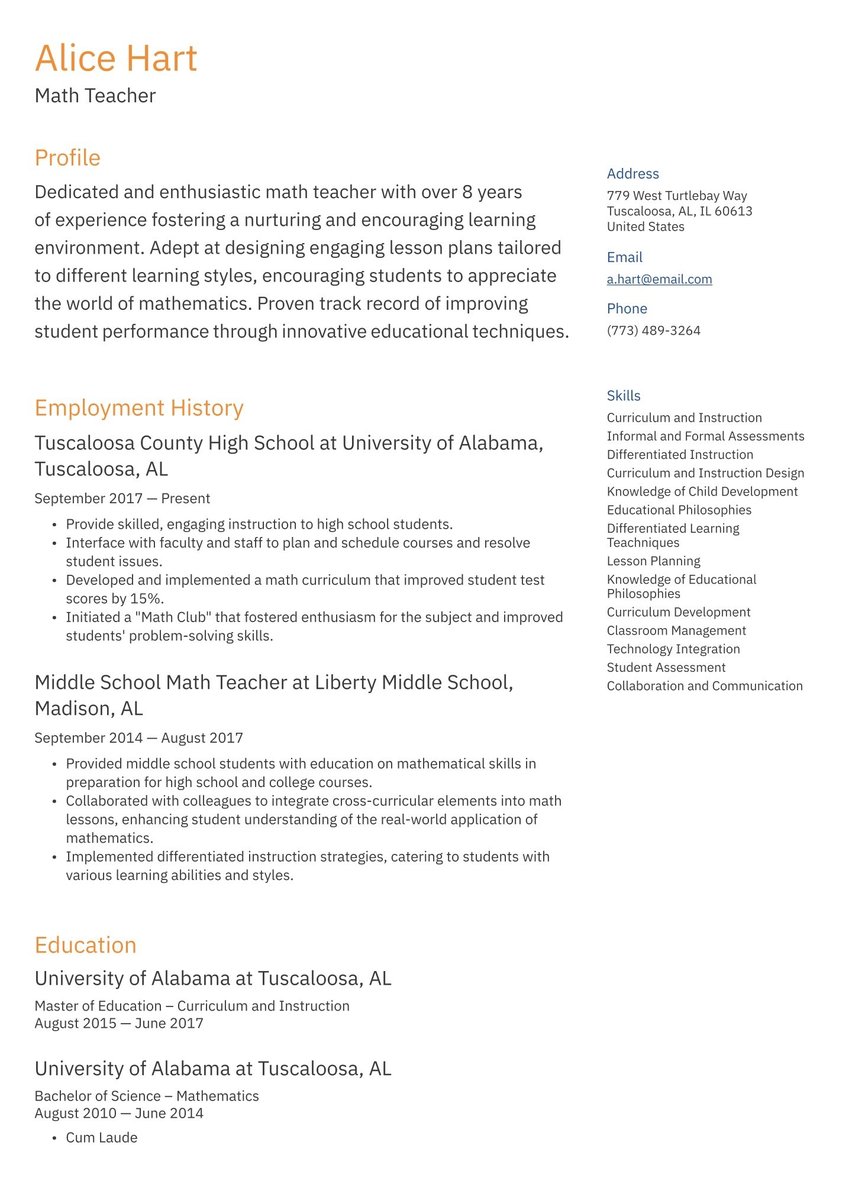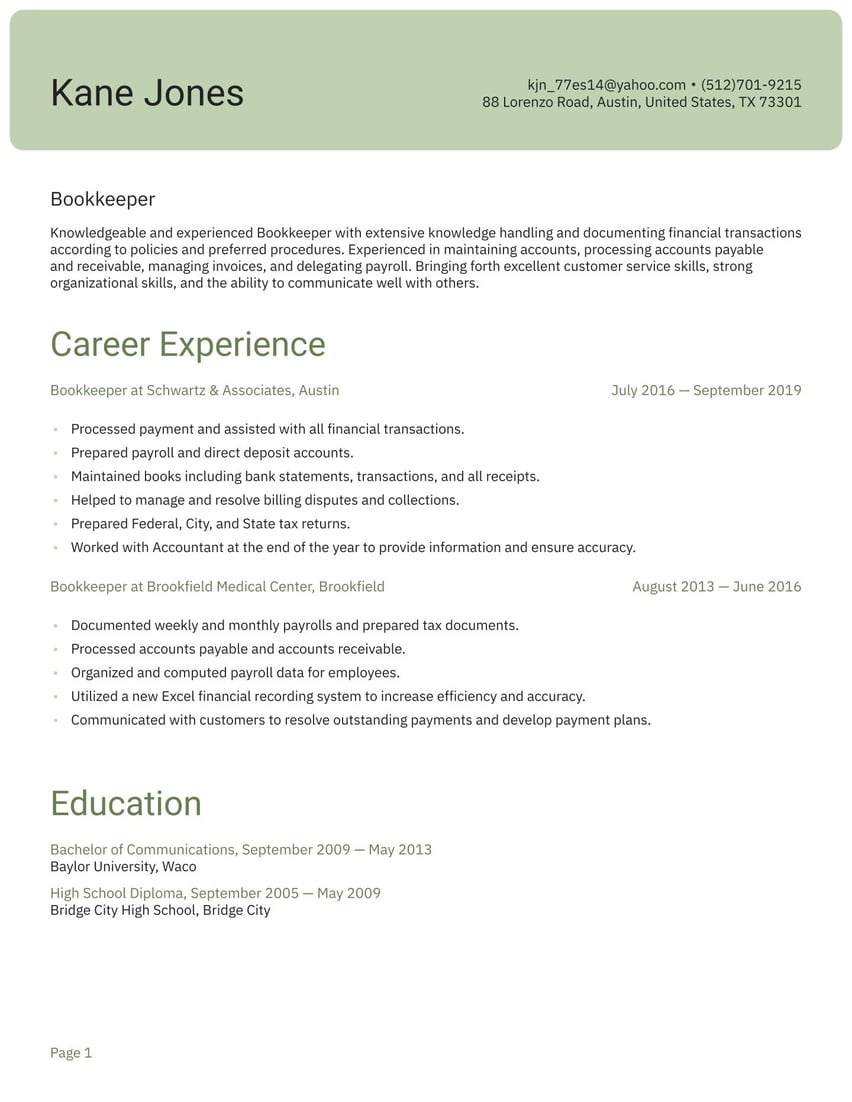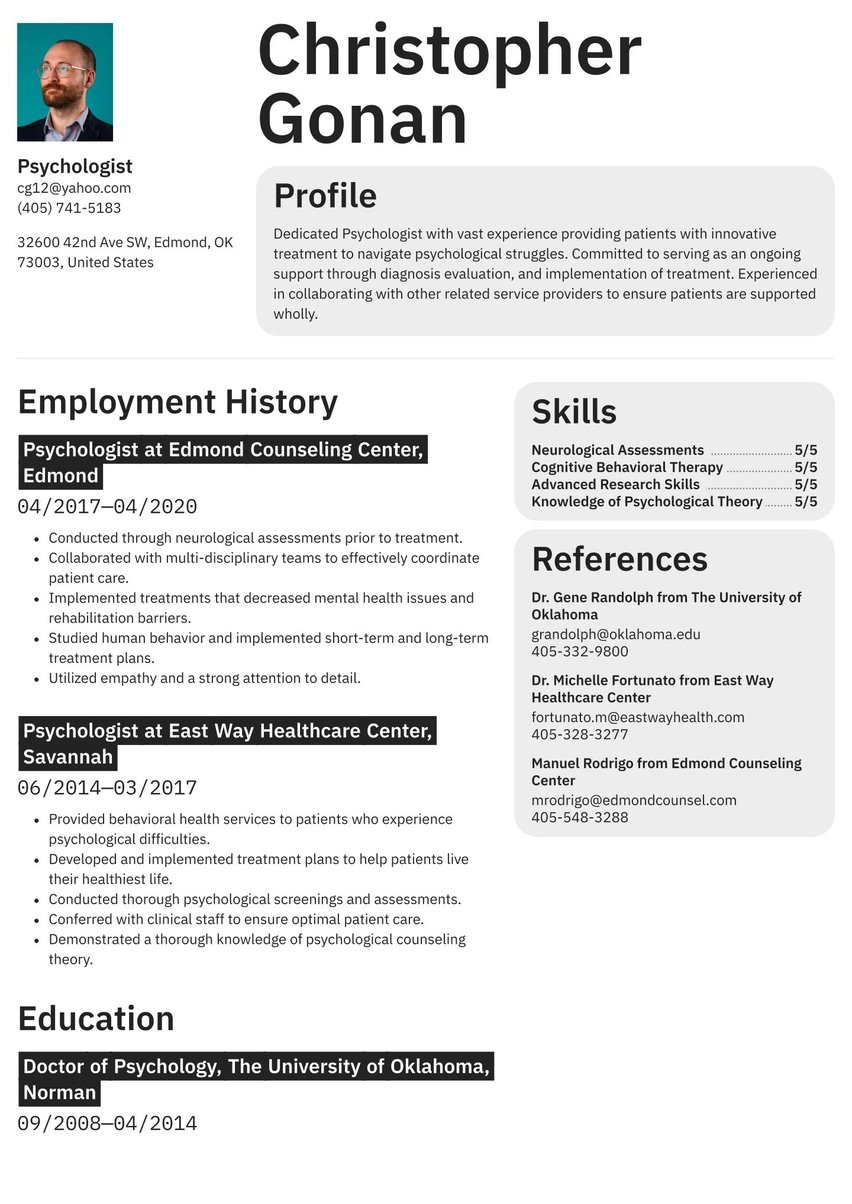Art directors need the skills to wow viewers at a glance — whether the purpose is to entertain, to amuse, to persuade or to convey information quickly. And when the person you need to impress is on the hiring end of a dream job, a standout art director resume may be your most important art project ever.
Art Director resume examples by experience level
Ideas, inspiration and practical advice from Resume.io can be a great launching point. We’ve developed more than 300 occupation-specific resume guides and resume samples to help job seekers around the world succeed in making their next career move. The same kind of support for cover letters is also available, along with information and tips on a wide range of job search topics.
To this knowledge, add your own personal and creative touches to create a winning art director resume. This writing guide, backed by art director resume samples, will cover the following aspects:
This guide will offer resume samples and address the following crucial aspects of a winning art director resume:
- The role and job market outlook for art directors
- An overview of how to write a bulletproof resume for this position
- The best format for structuring an art director resume
- Step-by-step advice for each resume section: header, summary, employment history, education and skills
- Layout and design tips to help showcase your greatest talents and skills in the best possible light.
What does an art director do?
Art directors are visually-savvy artists who know how to get their point across in images. They work in a variety of different fields, but their main task is to create the overall visual character of products, films, magazines, newspapers, or anything else that uses color, graphics, fonts, photos, and other images. Art directors are often also responsible for managing the group of artists who will carry out their vision for those products.
Understanding the job market
Understanding the hiring environment is vitally important for creating a resume that hits home. The job outlook for art directors is vibrant in the next decade, so you need to stand out from the crowd to compete for the best opportunities.
The continuing shift from traditional print publications to digital media is increasing the demand for art directors qualified in website and mobile platform design. The U.S. Bureau of Labor Statistics projects the job market for art directors to grow by 11% between 2020 and 2030, faster than the average for all occupations..
This forecast makes it all the more important that you tailor your resume to what employers will actually be seeking in the years ahead. Meanwhile, the financial reasons to pursue a career as an art director remain compelling. According to BLS data, the median annual income for art directors in 2020 was $97,270.
“The challenge for us is digital,” said Russel Herneman, art director of the British weekly The Sunday Times, which was recognized by the Society of News Design as one of the world’s best designed newspapers, in an interview with SND. “How to replace the dynamism of a yard-wide double-page spread on a phone screen three inches wide?” Thousands of art directors worldwide are facing the exact same challenge as more creative and visual products are going digital and/or mobile. Emphasize your skills in digital, online and multimedia, and you’ll have a leg up.
2020 data from the BLS indicates these are the U.S. industries employing the most art directors.
| Top fields of employment | Art directors employed | % Industry employment | Annual mean income |
| Advertising, Public Relations, and Related Services | 11,610 | 2.56 | $ 120,230 |
| Motion picture and video industries | 3,580 | 1.09 | $ 141,480 |
| Newspaper, periodical, book and directory publishers | 2,980 | 1.09 | $ 98,440 |
| Specialized design services | 2,790 | 2.07 | $ 111,250 |
| Management, scientific and technical consulting services | 2,700 | 0.18 | $ 106,790 |
How to write an art director resume
Writing an art director resume that lands interviews starts with knowing the core resume elements and how to write them:
- The resume header (the attention-grabbing design element)
- The resume profile / summary
- The employment history section
- The education section
- The skills section
The key to writing an effective resume is to maximize the impact of each resume section. You need to know what each of them is about, what psychological effect to aim for and what tricks to use for a positive impression.
As an art director, you can appreciate the thought and care that should go into an eye-pleasing header design that clearly identifies who your resume belongs to, your occupation and contact information. It might also include social media links and a photo.
Before going through each of the other resume components one at a time, we have some general writing advice to offer here.
Your job is to convince hiring managers that you are the right person for the job. Not only is your eye impeccable, but you have marketing sensibilities and are an excellent manager. You do that by using strong descriptive language, without crossing the line into bragging territory.
Get out that thesaurus. OK, really go to Synonym Finder or a similar site and vary your word use.
Obviously, the writing style and tone of every resume is different. Especially in creative professions. That's why it's good practice to have as much reference material as possible. For this purpose, you can check out our resume examples for related marketing roles, such as:
- Digital Marketing Manager resume sample
- Marketing Manager resume sample
- Social Media Manager resume sample
- Marketing Associate resume sample
- Digital Marketing resume sample
- Event Planner resume sample
- Content Writer resume sample
- Marketing Consultant resume sample
- Magazine Editor resume sample
- Blog Writer resume sample
- Content Marketing Associate resume sample
- Advertising Director resume sample
- Content Acquisitions Director resume sample
- Creative Director resume sample
- Marketing resume sample
- Brand Ambassador resume sample
- Brand Manager resume sample
- Public Relations resume sample
- SEO resume sample
- Marketing Coordinator resume sample
To be a great art director, you must have strong, creative ideas and know how to communicate those ideas to others. That means in addition to your artistic abilities, you have to be a great people-person, according to Creative Bloq, a web magazine for professional artists. But, a resume is text, so you have to be able to present yourself well on paper, too.
Beat the Applicant Tracking System
Applicant Tracking Systems (ATS) are automated programs that recruiters and hiring managers use to rank resumes based on the keywords contained in the resume. Employers input the words they’re looking for, and if your resume doesn’t match those requirements, they can be spared the trouble of even looking at your application. On the other hand, if you hit all the right notes, you can move swiftly to the top of employers’ must-read lists.
So how do you know what kind of language employers like to read in a resume? Look at their job posts. Keywords are usually related to job requirements, important qualities and skills, etc. For an art director, they might include: graphic design, illustration, creative design, Adobe InDesign, Adobe Creative Suite, Adobe Photoshop, Adobe Illustrator, user experience, HTML or social media.
Choosing the best resume format for an art director
What's the best format for structuring an art director resume? The answer is surprisingly tricky. Most resumes use the reverse chronological resume format, with the employment history section, taking up the most space and emphasizing past jobs in order from most recent to oldest.
Although this common chronological format is also well suited to many art director resumes, exceptions are not unusual due to the occupation’s creative nature and applications across multiple industries. For this reason, many art directors may choose the functional resume format, emphasizes skills or projects instead of employers. Others opt for a hybrid (combination) format, splitting the focus between work history and skills or projects.
Here are some factors that may impact the choice of resume format for an art director:
- Art directors may be predominantly creative professionals who emphasize their project portfolio rather than a traditional employment background. This often applies to those who have worked independently in consulting or freelance roles rather than as company employees.
- Depending on the specific position being sought — including the industry, creative medium and technological tools, art directors may emphasize completely different skills in each version of their resume.
- In fact, some art directors are more skills-focused, while others are more management-focused
Any of these factors can be a basis for looking at your work history and deciding whether you want to structure your resume around employment at agencies or companies, or rather emphasize your niche and/or valuable skills with links to your project portfolio. You may even want to land on a middle ground, showing a few key job roles while noting your most impressive freelance projects alongside them.
The resume example presented here uses a reverse chronological resume format that is ideal for an art director with a robust employment history of traditional employers.
Resume summary example
The summary of your art director resume is vitally important as your first chance to make a positive first impression on an employer, A resume usually contains several lists. This is not one of them. The summary (sometimes called profile or personal statement) is usually a two- to three-sentence recap of all the reasons you’re the perfect candidate for the job.
If your employment history is less than stellar, or you went to a college nobody has heard of, there’s not much you can do about that. But the profile allows you to make a case for your candidacy directly to your prospective employer.
Don’t be too modest. Try to look at this ‘pitch’ from the perspective of the hiring manager. Is it sincere and energetic? Does it paint an attractive professional image? Try to sound assertive without being arrogant, and confident but not cocky. You need to provide some compelling reasons why you would be a good hire.
Below is a resume example of a profile/summary.
You don’t necessarily need to use complete sentences. Resume language usually omits the “I am”: “Creative, driven, endlessly imaginative and always collaborative.” See how this writing style is used in the resume sample below.
Passionate and experienced Art Director with a proven track record of successfully leading art direction for projects, and achieving high levels of client satisfaction. Adept in overseeing all visual aspects of a project and offering design solutions when needed. Bringing forth strong leadership skills, and the creativity necessary to effectively oversee creative development and design processes.
Employment history sample: what have you done for us lately?
It’s the oldest Catch-22 in employment history: You can’t get a job without experience, and you can’t get experience without a job. But there are work-arounds you can manage through your art director resume. If you have a stellar job history as an experienced art director at well-known companies, you’re golden. But even if most of your experience is as a graphic artist or illustrator, there’s no rule that says you can’t move up to a higher rank.
In your art director employment history (job history and work experience are interchangeable terms), it’s best to emphasize what you accomplished and not just what your responsibilities were. Rather than saying “Responsible for monthly cover design of XYZ Magazine,” say, “Worked with editors, artists and photo desk to design 32 monthly covers for XYZ Magazine.”
List your job history in reverse chronological order, which will presumably put your most impressive work accomplishments first. Studies have shown that recruiters spend an average of only six to eight seconds on their first glance at a resume, so it’s crucial to put your most impressive achievements first.
After each job listed, add bullet points listing what you achieved in this role. Use strong action verbs and be detailed, yet concise.
Below is an art director employment history resume sample you can use while writing your own.
Art Director at Eight and Eight, New York
June 2013 - September 2019
- Supervised creative teams and worked to accomplish 100% client satisfaction.
- Oversaw all aspects of design and development, and offered design solutions when necessary.
- Managed multiple accounts at once, and won Leadership Awards two years in a row.
- Offered design solutions that effectively solved problems and enhanced advertising goals.
- Worked to motivate and support all creative staff, resulting in excellent workflow and productivity.
Junior Art Director at Coca-Cola, New York
May 2010 - May 2013
- Worked to support the senior creative staff with day-to-day tasks.
- Assisted the conceptual team to bring concepts to fruition.
- Utilized crucial design software skills to assist with projects.
- Engaged professionally with clientele to ensure high satisfaction rates.
- Assisted with all aspects of the creative process from copywriting to design and execution.
Promote your art director portfolio
Most artists have a secret weapon to supplement their resume: a portfolio of art projects they have either created personally or managed in an art director capacity. Note that most other professionals are not equipped to just attach an images or links within their resume to show employers why they are their next best hire. But in your creative field, where website portfolios have become relatively common, you should — and must — do exactly that.
A graphic designer or artist may link to any of the following collections of stunning illustrations: A breathtaking photo gallery. An illuminating digital project. A magazine cover or newspaper centerpiece. A web animation. As an art director, your portfolio may demonstrate even larger-scale projects: a movie set, an ad campaign, a video game — any of these can be presented as a striking visual in a single webpage or a landing site.
It’s true that most resumes should be as brief as possible but you can supplement your resume with additional tools, documents or links if you have spectacular visuals that demonstrate your talent at a glance.
To avoid bloating your resume beyond one page, try one of the following:
- Submit your portfolio projects, art or design pieces as hyperlinks in the appropriate work experience bullet points.
- Provide an additional PDF with your portfolio projects if you’re submitting via email, or if the job application software allows this.
- Create an online portfolio (either on platform like Behance or on your own website).
The latter is the most effective option, as it allows for a laconic inclusion into your resume. It’s the most visually impressive as well.
In the old days, candidates for art jobs used to go to interviews lugging a portfolio the size of a flat-screen TV, with samples of their paper artwork pressed between plastic inside. Nowadays, all of your best work can be submitted digitally, one page at a time, in a format that won’t break the limits of your target’s inbox. If possible, create a portfolio website with the URL YourName.com (or similar), and display all your best work there, with brief explanations of how you pulled it off. It’s an excellent way to supplement a perfect resume. And it displays enormous confidence that you turned your name into a website.
The 2019 Design Census, which draws from a partnership between the American Institute of Graphics Arts, Google Design, Eye on Design and Accurat, says “art director” was among the most common job title among designers of all kinds:
17%: Senior designer
14%: Design lead or manager
14%: Mid-level manager
11%: Art director
11%: Creative director/director
Art director resume education example: The training behind your talent
An art director CV without a college degree would be a great rarity (though it's not unheard of). According to the U.S. Bureau of Labor Statistics, art directors must have at least a bachelor’s degree in art or design, as well as previous work experience as graphic designers, illustrators, photographers or related occupations. If you do have a university degree in a relevant field, you’re good to go — and in fact, you may want to move up your education section higher on your resume, especially if you went to a stand-out school.
The 2019 Design Census surveyed 9,429 designers on their educational backgrounds and found the following answer:
32%: Bachelor’s degree
17%: Online learning
12%: “I was born this way”
10%: Workshops/similar programs
But whatever your degree is in and wherever it came from, you can tweak the education portion of your resume to highlight any training that helped make you a superior candidate. Did you attend seminars or workshops to improve your skills in art-related computer applications? Did you obtain any certifications in relevant fields? Did your education involve business administration or management? All of these can be relevant to your education experience.
Here’s a resume education section example below.
Bachelor of Graphic Design, Boston College, Boston
August 2006 - May 2010
High School Diploma, Forest Hills High School, Forest Hills
September 2002 - May 2006
Resume skills example: what are your strengths as an art director?
The skills section of a winning resume is where you highlight the strengths you have that are most relevant to the job you seek. It’s also a place where you can emphasize talents that aren’t necessarily reflected by your job history or education.
Art directors must have a mix of hard skills — for example, talents in illustration, photography, graphic design, relevant software — and soft skills — the ability to work well with people, communicate effectively and manage others. The skills section of a winning resume is where you highlight the strengths you have that are most relevant to the job you seek. It’s also a place where you can emphasize talents that aren’t necessarily reflected by your job history or education.
Also, along with the summary, this part of your resume allows more flexibility to convey what you think is important to each employer. A resume is a dynamic document that can and usually should be tailored to each job application. The skills list is one of the places where you can do so.
Art directors have generally done many of the same jobs as the people they supervise, and this tends to inspire confidence in employers. If you’re a seasoned illustrator, an award-winning photographer, a whiz at Photoshop, InDesign or web animation, these are all skills that will bolster your case.
According to creativepool.com, the most important skills for art directors, especially in advertising, are:
- Be highly creative
- Have a thorough understanding of photography, typography and printing
- Have excellent interpersonal and communication skills
- Work well as part of a team, with a range of people
- Have an interest in social and cultural trends and fashions.
If you’re working in the area of design, take a look at the skills chosen by the 2019 Design Census:
15%: Art direction
8%: Drawing/painting
8%: Project management
8%: UI design
But artists can be intensely private people, preferring to work alone. They tend to eschew “design by committee,” and many don’t like to go to meetings. For art directors, however, it’s imperative to bridge the gap between the solitary artist and those you work with in an organization, including the top management. This is where your soft skills come in. Art directors tend to spend more time working with people than with paintbrushes. They must be excellent communicators and coordinators, so they must possess people skills. It’s important to highlight these on your resume.
Below is a skills resume example of how to highlight your talents.
- Advanced Communication Skills
- Leadership Skills
- Project Management
- Advertising Design
- Interactive Media
- Design Solutions
Resume layout, design and formatting: look the part
We’ve already addressed the best ways to ensure your art director resume loses no points for being poorly organized or badly written. Needless to say, the last thing you want is for an employer to decide at a glance that you’re wrong for the job because your resume is unattractive.
In any field, a resume needs a clean, clear layout. For art directors, it’s absolutely imperative that a resume showcase the candidate’s talents in design, style and typography. It needs to be bold, striking and immaculate, but never gimmicky. Be mindful of the possibility you’ll need to rein in your instincts for all things eye-catching. An inviting-to-read result is the goal of visual incentives that draw attention to the words, not the opposite kind of distraction.
ATS-friendliness is another resume design consideration. That means avoiding the kind of resume formatting bugs that can occur in non-PDF files or those from non-standard text editing apps. There’s a dire risk of rejection by the previously discussed ATS screening software, guaranteeing that your resume will never even be read.
Let your artistic expertise guide careful decisions about resume font style text formatting, graphic touches and color splashes. Allow ample white space in the margins and between lines to offset the black text-dense areas.
Make it even easier on yourself by using resume.io’s builder tool, together with one of our field-tested resume templates. Browse four style categories for the one that suits you best: Creative, Modern, Simple and Professional. Replace with your own text and stamp with your own originality for impressive results in no time.
Art Director text-only resume example
Profile
Passionate and experienced Art Director with a proven track record of successfully leading art direction for projects, and achieving high levels of client satisfaction. Adept in overseeing all visual aspects of a project and offering design solutions when needed. Bringing forth strong leadership skills, and the creativity necessary to effectively oversee creative development and design processes.
Employment history
Art Director at Eight and Eight, New York
June 2013 - September 2019
- Supervised creative teams and worked to accomplish 100% client satisfaction.
- Oversaw all aspects of design and development, and offered design solutions when necessary.
- Managed multiple accounts at once, and won Leadership Awards two years in a row.
- Offered design solutions that effectively solved problems and enhanced advertising goals.
- Worked to motivate and support all creative staff, resulting in excellent workflow and productivity.
Junior Art Director at Coca-Cola, New York
May 2010 - May 2013
- Worked to support the senior creative staff with day-to-day tasks.
- Assisted the conceptual team to bring concepts to fruition.
- Utilized crucial design software skills to assist with projects.
- Engaged professionally with clientele to ensure high satisfaction rates.
- Assisted with all aspects of the creative process from copywriting to design and execution.
Skills
- Advanced Communication Skills
- Leadership Skills
- Project Management
- Advertising Design
- Interactive Media
- Design Solutions
Education
Bachelor of Graphic Design, Boston College, Boston
August 2006 - May 2010
High School Diploma, Forest Hills High School, Forest Hills
September 2002 - May 2006
Key takeaways for an art director resume
- Declining employment in the print publishing sector has not prevented job market growth for art directors with digital media qualifications. The need for a stellar resume is no less important in the decade ahead.
- The design and content of your resume are partially a demonstration of the skills that make you a great art director, so there’s very little room for error.
- Your resume is a visual representation of your creativity and personal flair. You can’t afford to make it a dry recitation of your job history and education.
- ATS algorithms can sink the chances of the best candidate and elevate the chances of the worst. Don’t ignore this all-important component of good resume design and content.
- One size doesn’t fit all in this field, so you must tailor each resume to each prospective employer.
If you want to avoid mistakes and maximize your prospects for finding the job that’s right for you, use the proven builder tool and field-tested templates at resume.io.


.jpg)

.jpg)
